-
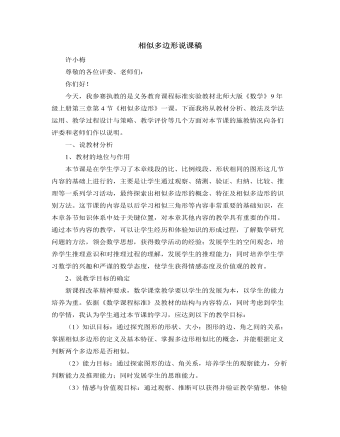
北师大版初中数学九年级上册相似多边形说课稿
五、说课件设计及板书随着教育现代化的发展,多媒体课件在课堂中辅助教师授课,帮助学生练习,已成为非常重要的教学辅助工具之一。在本节课的授课过程中,本人也使用了多媒体教学课件。课件在设计上遵循实用性原则、辅助性原则、创新性原则,紧紧围绕教学目标,服务于课堂教学,设计科学合理,制作精美细致;课件的有效使用很好地优化了课堂,极大地扩充了容量,有力地突出了重点,轻松地化解了难点;使学生学习兴趣浓郁,使教学效率大大提高;特别是在演示多边形对应角相等的设计,使这一教学环节变得更直观、更高效、更方便,让学生轻松地进行探究,很好地保护了学生的学习热情,方便了教师的策略实现。在授课过程中,我又不是完全依赖于多媒体课件,而成了课件反映员;我充分发挥教师的主导作用,合理地利用黑板板书有关内容,灵活动配合多媒体课件为学生呈现有关知识点,以弥补课件的不足。
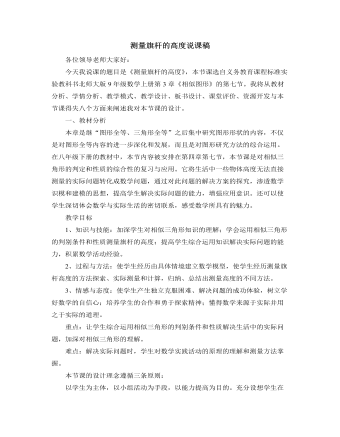
北师大版初中数学九年级上册测量旗杆的高度说课稿
在解决问题的过程中,学生使用到了生活中常见的工具——标杆、镜子等,这些小工具摇身一变就成了学生学习用的学具。使学生感觉到利用身边的工具完全可以达到解决问题的目的。八、本节得失本节课意在更好地让学生在实际操作中掌握相似三角形的判定与性质。这节课我感觉成功之处在于:1、立足于问题情境的创设。在课堂教学中创设良好的学习情境,充分激发学生求学热情。当学生的学习投入到教师创设的学习情境中,就会形成主动寻求知识的内在动力。学生在这种学习情境中主动学习到知识,比讲授给他们的要丰富得多,而且更能激发他们的学习兴趣。2、注意培养学生的问题意识。问题解决后,教师应让学生从解决的问题出发,通过对题目的拓展,引导学生用新的思维去再次解决新问题,这样不仅让学生掌握了更多的知识,还能让学生的思维得到升华。3、培养学生自主探索、合作交流的学习方法和习惯。
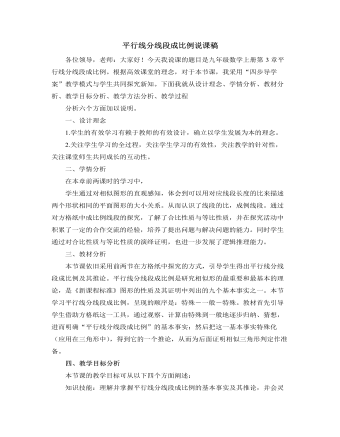
北师大版初中数学九年级上册平行线分线段成比例说课稿
三、达标测试这一环节,我共设计了5道题,题型有选择、填空、解答。这些题都来自于课后习题,是课后习题的重组和整合,能够很好地考查学生对本节课的掌握情况。这一环节设计以多变的题型呈现,总体还是以基础题为主,以课后习题为主要内容设计,可把课后习题改编成填空、选择、计算、解答、证明等。这些题的设计要有典性、代表性,要紧跟时代步伐。80%-90%的学生能做全对,题量不能超过6道题。学生答题时间不能超过8分钟。四、拓展延伸这一环节以综合运用推论的一道计算题呈现的。旨在让学生在课后巩固对推论的理解,另一方面也为后面学习相似三角形做铺垫。以上几个环节环环相扣,层层深入,并充分体现教师与学生的交流互动,在教师的整体调控下,学生通过动脑思考、层层递进,对知识的理解逐步深入,使课堂效益达到最佳状态。

北师大版初中数学九年级上册相似三角形的判定说课稿
(四)提高应用已知:在△ABC中,已知∠ACB=90°,CD⊥AB于D,请找出图中的相似三角形,并说明理由。设计意图:训练学生灵活运用知识的能力(五)小结反思1.、相似三角形的判定方法一:如果一个三角形的两个角分别与另一个三角形的两个角对应相等,那么这两个三角形相似. 2、在找对应角相等时要十分重视隐含条件,如公共角、对顶角、直角等. 3、掌握由平行线构造的两类相似图形:一类是A字型,另一类是X型. (回顾定理,强调两个基本图形,培养学生养成认真观察,注意寻找图形中的隐含信息的意识) 4、 常用的找对应角的方法:①已知角相等;②已知角度计算得出相等的对应角;③公共角;④对顶角;⑤同角的余(补)角相等.
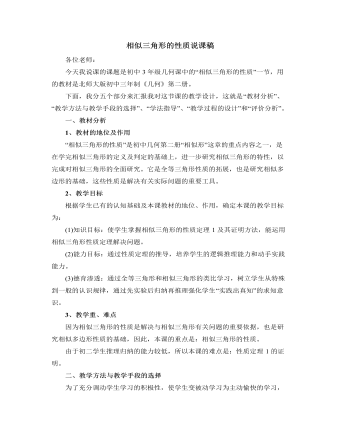
北师大版初中数学九年级上册相似三角形的性质说课稿
接着,引导学生回答命题1的题设、结论,教师把命题1的图示画在黑板上,得到以下的数学表达式。已知:如图,△ABC∽△A/B/C/、△ABC与△A/B/C/的相似比是K,AD、A/D/是对应高。求证:AD/A/D/=K首先让学生回忆,证明线段成比例学过哪些方法,接着引导学生分析证明思路:要证AD/A/D/=K,根据图形学生能找到含对应高和对应边的两对三角形,即△ADB和△A/D/B/、△ADC和△A/D/C/。若要证AD/A/D/=K,则应有△ADB∽△A/D/B/,由条件可知∠ADB=∠A/D/B/=90°,∠B=∠B/,于是可得△ADB∽△A/D/B/,得到AD/A/D/=K。随后,学生口述教师板书规范的证明过程。接着问学生还有哪些证明方法?同理可证得其他两边上的对应高的比等于相似比,所以命题1具有一般性。而对于命题2、命题3的数学表达式和证明方法与命题1类似,所以为了提高教学效率,用投影依次将命题2、命题3的已知、求证和题图显示出来,并指导学生课堂练习证明这两个命题。
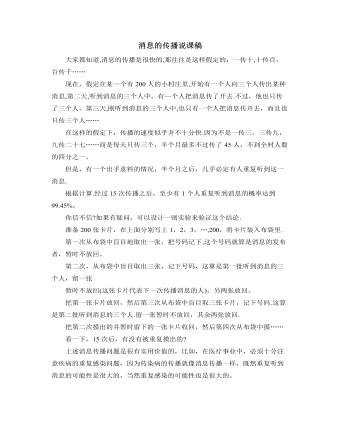
北师大版初中数学九年级上册消息的传播说课稿
准备200张卡片,在上面分别写上1,2,3,…,200,将卡片装入布袋里.第一次从布袋中盲目地取出一张,把号码记下,这个号码就算是消息的发布者,暂时不放回。第二次,从布袋中盲目取出三张,记下号码,这算是第一批听到消息的三个人,留一张暂时不放回(这张卡片代表下一次传播消息的人),另两张放回。把第一张卡片放回,然后第三次从布袋中盲目取三张卡片,记下号码.这算是第二批听到消息的三个人.留一张暂时不放回,其余两张放回.把第二次摸出的并暂时留下的一张卡片收回,然后第四次从布袋中摸……看一下,15次后,有没有被重复摸出的?上述消息传播问题是很有实用价值的,比如,在医疗事业中,必须十分注意疾病的重复感染问题,因为传染病的传播就像消息传播一样,既然重复听到消息的可能性是很大的,当然重复感染的可能性也是很大的。
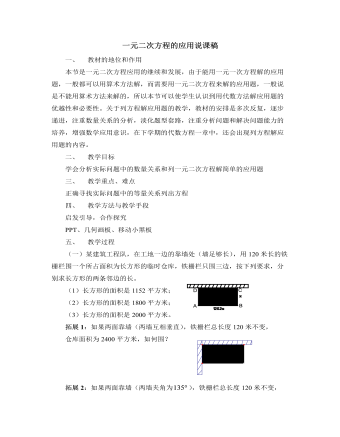
北师大版初中数学九年级上册一元二次方程的应用说课稿
(三)如图, 中, ,AB=6厘米,BC=8厘米,点 从点 开始,在 边上以1厘米/秒的速度向 移动,点 从点 开始,在 边上以2厘米/秒的速度向点 移动.如果点 , 分别从点 , 同时出发,经几秒钟,使 的面积等于 ?拓展:如果把BC边的长度改为7cm,对本题的结果有何影响?(四)本课小结列方程解应用题的一般步骤:1、 审题:分析相关的量2、 设元:把相关的量符号化,设定一个量为X,并用含X的代数式表示相关的量3、 列方程:把量的关系等式化4、 解方程5、 检验并作答(五)布置作业1、请欣赏一道借用苏轼诗词《念奴娇·赤壁怀古》的头两句改编而成的方程应用题, 解读诗词(通过列方程,算出周瑜去世时的年龄)大江东去浪淘尽,千古风流数人物,而立之年督东吴,早逝英年两位数,十位恰小个位三,个位平方与寿符,哪位学子算得快,多少年华属周瑜?本题强调对古文化诗词的阅读理解,贯通数学的实际应用。有两种解题思路:枚举法和方程法。

五年级上册音乐的教案
(1)听一遍范唱录音。 (2)讨论歌曲的歌词表现的是什么内容?(师生共同讨论)第一部分实际上只有两句歌词:“请把我的歌带回你的家,请把你的微笑留下”,歌声与微笑架起了友谊的桥梁。第二部分是引申,描绘了“友谊花开遍地香”的情景。这首歌虽然短小,意义却不小。

人教版新目标初中英语七年级上册Do you want to go to a movie教案
讨论喜欢的影视类型及理由:在看过一部影视作品后,大家总是喜欢在一起谈论影视的主要内容、主要情节、主要演员主题歌曲、主题音乐等,互相介绍自己对该影视的看法。教师可以组织一次活动,分组讨论学生喜欢看什么类型的电影,并说明喜欢的理由。运用I like…I don’t like…Because it is…等语言结构;然后每个组选派一名代表向全班学生阐述本组组员喜欢观看的电影类型;最后汇总,总结出全班同学最喜欢观看哪一种类型的电影。如果有可能,根据学生的选择放一部(一段)这种类型的影视节目。通过学生的讨论、调查,使他们在完成任务的过程中学会询问和陈述自己或别人在影视方面的喜好及理由,更好地巩固所学内容。Self Check教学内容Self Check(教材P58)教学目标知识与能力复习词汇go,movie,action,comedy,documentary,thriller,and,but,scary,funny, sad,exciting;引导学生复习、巩固“制订计划和打算并谈论喜好和偏爱”的目标语言。

人教版新目标初中英语七年级上册My favorite subject is science教案
本单元主要学习一周中星期一到星期天的表达方式;掌握学科的表达;学习用because和表示品质的形容词表示理由;学习what,why,who引导的特殊疑问句。本单元围绕“谈论自己所喜欢的学科”这一话题,设计了三个任务型活动:任务一是:谈论自己所喜欢的学科,学习what引导的特殊疑问句和学科的表达;任务二是:一分钟演讲,让学生介绍自己喜欢某一学科的理由,学习why等特殊疑问句;任务三是:写信,巩固和延伸所学知识,掌握星期的表达方式。单元知识系统(树)What’s your/his/her favorite subject? My/His/Her favorite subject is English.Why do you like math. Because it’s interesting.Why does he/she like art? Because it’s fun.When do you have math? I have math 0n Monday,Wednesday and Friday.What’s Ken’s favorite subject? Science.单元总体目标通过本单元的学习使学生学会谈论自己喜好的学科或自己喜好的其它事情并给出理由;学会说出一周的七天;学会合理地安排自己的作息时间。

人教版新目标初中英语七年级上册What time do you go to school教案
知识与能力复习词汇time,morning,breakfast,get up,g0 t0 bed,homework,clock,afternoon,lunch,run,watch TV,evening,dinner,eat,usually,o’clock,thirty,fifteen,take a shower,go t0 school等;引导学生复习、巩固“询问和谈论时间”的目标语言并运用所学知识安排自己的学习和课外活动。过程与方法运用Summarizing,Classifying和Comparing的学习策略。在复习教学中,运用听写、提问、对话演练与调查活动,促使学生不断地使用所学内容,从而提高他们灵活运用知识的能力。情感态度价值观本部分的主要内容是复习“日常作息时间”的询问和表达。通过互相询问或谈论自己或对方的作息时间安排和活动计划,培养学生良好的作息习惯和守时习惯。教学重、难点及教学突破重点复习词汇time,morning,breakfast,get up,g0 to bed,homework,clock,afternoon,lunch,run,watch TV,evening,dinner,eat,usually,o’clock,thirty,fifteen,take a shower,go to school等;引导学生复习、巩固“询问和谈论时间”的目标语言。

人教版新目标初中英语八年级上册Can you come to my party教案3篇
Step 3 (3b)First, tell the students when we talk about our future plans, we often use: I’m+verb+ing When we talk about what we must do, we use have to. Ask the students to fill in the blanks in 3b. The answers are: shopping, go to see, a test, I’m going, my family. Step 4 (3c)Let the students write an e-mail message to a friend. Say why you can’t visit next. Before the exercise, ask the students to give some possible answers and write them on the blackboard. So the students will feel easy to finish the writing exercise. After they finish it, Let them to correct it in groups first. Each group chooses theirs best one to read in front of the whole class. Step 5 ( planning a party )First read the conversation in the box together. Then ask the students to turn to page 88.Write down everything you have to do next week. Write in all the things you have to do . Ask the students to look at the list. Ask them “What day are you free?” This is when you can have your party. Step 6 (Self check 1 )Let the students to fill in the blanks with the words given. Change the forms of the words if possible. Then make their own sentences. The answers are: visit, playing, have to, study, comeStep 7 (Self check 2)Imagine you are Marie. Read the information and look at your schedule. Write replies to the invitation.

人教版新目标初中英语八年级上册How was your school trip教案2篇
“Go for it!” is based on “Task-Based Language Teaching”. It adheres to “The authenticity principle”, “The form-function principle”, “The task dependency principle” and “The principle of learning by doing”. These principles all accord with the demands of curriculum focus.In and of Grade Seven (II), “Go for it!”, students have learned “The Simple Past Tense”. And it appears again in of Grade Eight (I). teaches students more about how to talk about events in the past. In addition, it gives affirmative and negative statements in the past tense, such as the sentence patterns “Did you see …?” “Were there …?” “Did you go …?” As the first part of Unit 8, Section A opens with a picture presenting the last school trip in the aquarium and continues with several step-by-step practice activities, which are all good for students to master “The Simple Past Tense”. Doing well in Section A will help students integrate the new target language with that in Section B. Thus, they can describe the events in the past freely and foster their own ability of reflecting and practicing. II. Teaching ObjectivesTeaching objective is the beginning and aim of teaching activities. According to the overall goal of the English elementary course--- improve students' synthetic ability of language application, which should be based on the development of students’ “Language knowledge”, “Language skills”, “Character building”, “Learning strategies” and “Cross-cultural awareness”. The teaching objectives are described as follows(I). Knowledge objectivesi. Master the simple past tense of regular and irregular verbsii. Recite the new words and expressions about the last school trip in the aquarium, including their pronunciation and intonation

人教版新目标初中英语八年级上册Could you please clean your room教案3篇
一、 教学内容Section A 1a----1c二、 教学目标1.学习词汇do the dishes, make the bed, take out the trash, fold the clothes, do the laundry, sweep the floor, clean the living room.2.句型 Could you please clean your room? Yes, sure.三、 教学准备 学生预习本单元所有的词汇多媒体课件 活动表 奖品四、 教学过程Pre-task1. Warming upEnjoy ourselves. Watch cartoon Cinderella. 看动画片段《灰姑娘》导如入本课话题和新词汇“chores”美丽善良的鬼姑娘因继母的嫉妒,每天得做所有的家务。片段的主题使学生联想到本课的话题。2. learn new words and phrasesLook! What is she / he dong? 看图学习动词词组do chores, do the dishes, make the bed, take out the trash, fold the clothes, do the laundry, clean the living room.3. Guessing game.What is she doing ? 4. Pair work. 1a, Do you do these things at home? Write “Y” for “yes” and “N” for “no”.5. Listening . 1b , Peter’s chores or Mom’s chores?理解目标语Could you please clean your room? Yes, sure.Write “M” for Mom’s chores, “P” for Peter’s chores in the chart.6. PairworkLook at the picture,Ask your partner to do the chores that you see. 7. Interview Who is the most able at home? 1) What chores do you do at home? How often do you do the chores? Work in four, interview each of the students in the group, fill in the chart.

人教版新目标初中英语八年级上册How do you get to school教案2篇
Step Ⅶ Role play ( Work on 1b)1. First ask two students to read the dialogue to the class.Sa: How do you get to school?Sb: Well, I ride my bike to the subway station. Then I take the subway.2. Now work with a partner.Suppose you use two kinds of transportation to get to school \Hangzhou\Beijing... (bus, train, subway, walking, bike, etc.) Tell how you get there. You may use the phrases in 1a.3. Then ask different pairs of students to present their conversations to the class.Step ⅧListening1. Work on 2a(1) First ask students to read the list of information that Thomas wants to know.…where Nina lives.…how far from school she lives.…how long it takes to get to school.…how she gets to school.…what she thinks of the transportation.(2) Tell students what transportation and bus stop mean.bus stop 汽车站 transportation n. 运送;运输Then tell students we'll hear a recording. Please put a checkmark in front of each thing that Thomas wants to know.(3) Now play the recording for students.( Have students pay attention to the sample answer.) (4) Then correct the answers.

人教版新目标初中英语八年级上册What are you doing for vacation教案2篇
Teaching goals : 1. Words & phrases: babysit ,get back , fishing , rent , think about , decide(on) , tourist etc. 2. How to talk about future plans . 3. 现在进行时表示将来计划或行动. 4. 特殊疑问句(where , when , how long引导) Important and difficult points : Drills :What are you doing for vacation ? I’m watching TV . When are you going ? I’m going … . How long are you staying ? We’re staying for five days . Teaching aids : cards and a tape ,a large wall calendar . Period 1 Teaching procedures : Step 1Leading in1. Free talk . 2. Put up the wall calendar . T: I’m staying home on Saturday (pointing to next Saturday ).Ss repeat . Ss: I’m staying home on Saturday . T: OK. Today we’ll learn how to talk about future plans. Step 2Pre-task SB Page 13 , 1a . 1. Look at the picture carefully and tell what you see in the picture . 2. Write the activities from the pictures in the box and add some more . 3. Practice reading . Step 3While-task1. Using the activities we write in 1a to make conversations .For example :What are you doing for vacation ? I’m visiting my uncle . 2. Pairwork .Practice in pairs . 3. 用第三人称练习对话.

人教版新目标初中英语八年级上册I’m more outgoing than my sister教案2篇
1 交通工具的比较此活动为小组活动。学生通过讨论找出到达某一城市可乘坐的各种交通工具,并选择最佳出行方式。Teacher:We’re going to Shanghai. How many ways can we use to get there? Yes, there are four ways: by bus, by plane, by train, by ship. Please discuss how you are going to get there.操作建议:(1)学生以小组为单位展开活动,谈论本组所选择的交通工具。(2)各组选代表向全班汇报,阐述本组所选择的交通工具的利和弊。完成任务所需要的语言结构:We can go there by ship. It’s more comfortable and cheaper than any other transportation.We can go there by bus. It’s cheaper but it takes longer time.2 哪个城市更合适?此活动具有挑战性。假设中国要举行2014年世界杯足球赛,分别从历史,人文,天气等方面对各城市(北京,大连,上海,昆明)进行比较,选择最佳举办城市。T: Imagine China is holding the 2014 FIFA World Cup. Which city do you think is the best for the World Cup, Beijing, Dalian, Shanghai or Kunming? Let’s work in groups. If you choose Beijing, please join the Team Red. If you chose Dalian, please join the Team White. If you choose Shanghai, please join the Team Blue. If you choose Kunming, please join the Team Green. Please show us its advantages. Then let’s see which team will win.

人教版新目标初中英语八年级上册What’s the best radio station教案2篇
教学重点和难点:运用所掌握的语言描述,比较不同地点的特点。在练习中学习掌握英语比较级和最高级的用法。课前准备分配小组,每组五至六人。通过上网或翻阅报刊杂志等方法,确定旅游线路,做出基本的旅游计划。教学设计:本节课流程图 学法指导:1.由于这是一堂新课,在教学中应注意面向全体,发挥学生的主体性,引导学生积极参与,激发学生的求知欲和学习积极性,指导学生积极思维,主动获取知识,养成良好的学习方法。逐步学会独立解决问题。总之要尽可能调动学生的非智力因素促进智力因素的发展。教法选择:1.电化教学法2.课堂讨论法3.任务型教学法采用这些方法的目的是为了充分调动学生的学习积极性,使学生变被动学习为主动学习。通过电脑形象的演示,加强印象,提高兴趣,突破难点,提高教学效率,进而增大教学的容量和信息量。充分体现教师为主导,学生为主体的教学原则。

人教版新目标初中英语八年级上册What’s the matter教案2篇
She shouldn’t go to the party tonight.Step7. TaskT: You know, there are lots of problems in our life. If you are a doctor, please tell us how to solve the problem. I will divide you into 9 groups. Please work in groups. And then choose one of you to report your ideas.The following are the problems:I have a toothache.I am hungry. I have a sore throat.I am stressed out. I have a sore back.I am tired. I can’t sleep.I have a cold. I have a headache.Report: If you have a headache, you should go to bed early. You should see the doctor. You should eat some medicine. You shouldn’t wash your face with cold water.You shouldn’t sleep late.You shouldn’t swim.…..T encourages the students to give advice as much as possible.Homework:1. Chose one of the problems, and write down your advice2. Copy the new words这一步是用于热身的,同时也可以让他们复习一部分的表示人体部位的单词,扩充知识.学习语言的过程也是一个不断积累的过程,复习旧知识,增添新知识.通过小游戏,强化学生对Does she/he have…这个句子的运用能力.通过复习,自然的引到下面新知识的学习。充分利用表格,由句子到对话,再到文章,让学生循序渐进. 提高学生的综合语言运用能力,运用以前学过的知识来解决身边的问题.Period 5 (Section B 3a—3c, selfcheck)教学内容与分析:

人教版新目标初中英语九年级上册Teenagers should be allowed to choose their own clothes教案2篇
Step 1 Greeting Greet the class and check the homeworkStep 2 A duty report The S on duty gives a report on the rules in his home and lead in 3a “Sun Fei’s and Wu Yu’s rules” Step 3 ReadingSs read the conversation and write the two girls’ rules in the chart. Check the answers.Get Ss to read after the tape and then read aloud by themselves. Then, T explains the language points.Step 4 Pairwork 3bRole play. Use the information in chart to practice with the conversation in 3a covered. They can look at the sample conversation in the right box.Step 5 Task 2 “Who’s the best reporter?”Make a survey by asking any 5 students the questions in the chart in activity 4. Then give out a report about it. See who is the best reporter? And the best reporter will get a nice ball-pen.Step 6 Summary and homework:Write out the report in your exercise-books.Period ThreeStep 1 Greeting and a duty reportThe S gives a duty report talking about his experience of being late for school. Lead in the question “Do you ever get to school late? How often do you get to school late? Always, usually, sometimes, or never?Step 2 1a Get Ss to finish writing.Step 3 Pairwork 1b Get Ss to talk about their answers with their partners using the sample conversation in the box on the right.Step 4 Listening practice2a Lead-in: What will happen if you get to school late? What about Peter? Let’s listen to a conversation between Peter and his father. Get Ss to finish 2a (As usual, for the first time, Ss only listen.) Check the answers.